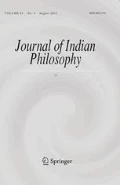Abstract
Accounts of creation in Sanskrit literature include a number of hymns in the R̥gveda principal among which are R̥V 10.72, 10.81–82, 10.90, 10.121, and 10.129. Later accounts appear in the Mānavadhārmaśāstra, the Mahābhārata, and purāṇas. Scholars generally describe these accounts as various, mutually inconsistent myths, or as superseded stages of philosophical thought. Even recent treatments of Indian cosmogony that praise the poetic subtlety and prowess of their composers consider their work as products of individual poetic imagination. Yet, despite the variety of expression in the various accounts, they appear to convey a consistent model of the origin of the world. Moreover, the model of the absolute and the first stages of creation mirror the descriptions of the development of enlightenment in foundational texts of Vedānta and systematic analyses of Yoga. The descriptions of creation may therefore rather be the result of the special insight of enlightened sages than the results of individual imagination.
Similar content being viewed by others
Notes
The neuter term bráhman has the vowel of the first syllable high-pitched; the masculine brahmán has that of the second syllable high-pitched. Scholars often write the masculine capitalized in the nominative singular Brahmā while they write the stem of the neuter without capitalization.
Hume (1971, p. 184) translates ‘prayer’.
Keith (1925, p. 433) refers to R̥V. 2.12.5 and 8.103.3 where reference is made to those who doubted Indra’s existence (anindrā́h), “But we are distinctly told that there were men who asked, ‘Who is Indra, who ever saw him?’ or asserted that he did not exist at all.”
Brown(1965, p. 30), “born of a lifeless egg” (mr̥tāṇḍa). Matsya Purāṇa 2.36: mr̥te ’ṇḍe jāyate yasmān mārtaṇḍas tena saṁsmr̥taḥ. Sāyaṇa on R̥V. 10.72.9: mr̥tād vyr̥ddhād aṇḍāj jātaṁ mārtāṇḍanāmānaṁ sūryam.
Macdonell (1897, pp. 9, 10) describes the region as filled with light where the waters and soma are, and where the celestial fire is produced.
This passage appears also at Br̥hadāraṇyaka Upaniṣad 5.15.1 and with variation at Maitrī Upaniṣad 6.35.
These two paths are discussed at greater length in Br̥hadāraṇyaka Upaniṣad 6.2–3, Chāndogya Upaniṣad 5.3–10, Kauṣītakī Upaniṣad 1, and Aitareya Upaniṣad 2.
I appreciate the assistance of Youval Eliav in combing the Bhagavadgītā for relevant passages.
One could argue that according to Yoga the self and nature are here two. Or worse, one could argue that there are many puruṣa’s according to Yoga. Hence the character of kaivalya is not at all similar to the one unmanifest which becomes the conscious agent of creation as well as developing into the entities of nature. However, the multiplicity of puruṣas in Yoga depends upon a single sūtra (2.22), and it may be argued that this sūtra merely describes the perspective of an unenlightened self. An unenlightened self views individual bodies in nature as analogous to his own and considers that each has within it a conscious self like itself. But for the enlightened self, all of nature ceases to exist; there is no question of a second element, not to mention multiple selves housed in bodies within it. From the perspective of the enlightened, then, the state of kaivalya is indeed comparable to the first stage of creation described even in the more Vedānta-like accounts.
References
Aurobindo, S. (2005). The life divine. 2. The complete works of Sri Aurobindo 21–22. Pondicherry: Sri Aurobindo Ashram.
Basham, A. L. (1967). The wonder that was India: A survey of the history and culture of the Indian sub-continent before the coming of the Muslims. Sidgwick & Jackson great civilization series (3rd ed.). London: Sidgwick & Jackson. [1st edition 1954. Reprint: New Delhi: Rupa, 1992.]
Brown, W. N. (1931). The sources and nature of puruṣa in the the Puruṣasūkta, RV. 10.90. Journal of the American Oriental Society, 51, 108–118.
Brown, W. N. (1942). The creation myth of the Rig Veda. Journal of the American Oriental Society, 62(2), 85–98.
Brown, W. N. (1965). Theories of creation in the Rig Veda. Journal of the American Oriental Society, 85(1), 23–34.
Frawley, D., trans. (1986). Hymns from the golden age: Selected hymns from the Rig Veda with yogic interpretation. Delhi: Motilal Banarsidass.
Hume, R. E., trans. (1971). The thirteen principal Upanishads: translated from the Sanskrit with an outline of the philosophy of the Upanishads (2nd ed.). London: Oxford University Press. [1st edition 1931].
Jamison, S. W., & Brereton, Joel P., trans. (2014). The Rigveda: The earliest religious poetry of India. 3. South Asia research. New York: Oxford University Press.
Keith, A. B. (1925). The religion and philosophy of the Veda and Upanishads., 2. Harvard Oriental Series 31, 32 Cambridge, MA: Harvard University Press.
Macdonell, A. A. (1897). Grundriss der Indo-Arischen Philologie und Altertum skunde (Encyclopedia of Indo-Aryan Research). Bd. 3, Hft. 1 A: Vedic mythology. Georg Bühler (Ed.). Strassburg: Karl J. Trübner.
Maurer, W. H., trans. (1986). Pinnacles of India’s past: Selections from the R̥gveda. Amsterdam: John Benjamins Publishing Company.
Müller, F. M., trans. (1886). The Laws of Manu: translated with extracts from seven commentaries. Sacred books of the East 25. Oxford: Clarendon Press.
Salomon, R. (1989). Review of Hymns from the golden age: Selected hymns from the Rig Veda with yogic interpretation by David Frawley, and Pinnacles of India’s past: Selections from the Rig Veda by Walter Maurer. Journal of the American Oriental Society, 109(3), 456–457.
van Buitenen, J. A. B., trans. (1973). The Mahābhārata: 1. The Beginning (Vol. 1). Chicago: University of Chicago.
Wilson, H. H., trans. (1850–1888). Rig-veda-Sanhitá: translated from the original Sanskrit. 6. Vol. 4 E. B. Cowell (Ed.).; v. 5 by E. B. Cowell, W. F. Webster (Ed.); v. 6 by W. F. Webster (Ed.). Imprint for v. 4–6: London: N. Trübner, 1866–1888. London: Wm. H. Allen.
Author information
Authors and Affiliations
Corresponding author
Ethics declarations
Conflict of interest
There is no conflict of interest.
Additional information
Publisher's Note
Springer Nature remains neutral with regard to jurisdictional claims in published maps and institutional affiliations.




